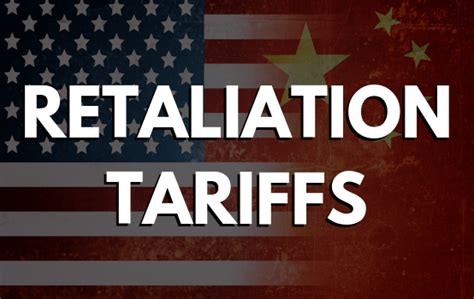
China’s potential retaliatory measures against new U.S. tariffs could significantly drive up housing costs for American consumers, industry experts are warning. The ripple effects of such actions could impact the affordability and availability of homes across the United States, exacerbating an already challenging housing market.
Economists and trade analysts predict that if China imposes countermeasures, particularly on materials vital to the construction industry, the cost of building new homes and renovating existing ones could surge. This could translate directly into higher prices for homebuyers and renters alike.
“If China retaliates by restricting exports of these essential materials, U.S. homebuilders will face higher costs, leading to increased home prices and rents,” explained one trade analyst quoted in a recent report. “This would further strain affordability for many Americans, especially first-time buyers.”
The escalating trade tensions between the world’s two largest economies are raising concerns about the stability of global supply chains and the potential for increased inflation. The housing sector, heavily reliant on imported goods, is particularly vulnerable to these disruptions.
The potential consequences of China’s retaliation extend beyond just the price of lumber. Experts highlight that a wide range of materials used in home construction, from steel and aluminum to plumbing fixtures and electrical components, could be affected.
“It’s not just about lumber,” warned an economist specializing in the housing market. “We’re talking about a broad spectrum of materials that are essential for building a home. If China restricts exports of these goods, it will have a cascading effect throughout the entire housing industry.”
The National Association of Home Builders (NAHB) has already expressed concerns about the potential impact of trade disputes on housing affordability. In a statement, the NAHB emphasized the importance of maintaining stable and reliable supply chains to ensure that builders can continue to provide affordable housing options for American families.
“We urge policymakers to carefully consider the potential consequences of trade policies on the housing market,” the NAHB stated. “It’s crucial to avoid actions that could further exacerbate the housing affordability crisis.”
The situation underscores the interconnectedness of the global economy and the potential for trade disputes to have far-reaching consequences on domestic markets. As the U.S. and China continue to navigate their trade relationship, the housing market will be closely watching for any signs of further escalation and the potential impact on American consumers.
Digging Deeper: The Materials at Risk and Their Impact
The potential impact on US housing costs goes far beyond lumber prices. China is a major global supplier of numerous materials crucial for residential construction. Here’s a closer look at some key components and how their price fluctuations might affect the housing market:
-
Steel and Aluminum: These metals are foundational in construction, used in framing, roofing, plumbing, and various structural elements. Increased tariffs or export restrictions on Chinese steel and aluminum would directly increase the cost of building materials, translating to higher home prices.
-
Plumbing Fixtures: China is a significant producer of plumbing fixtures like faucets, pipes, and fittings. Disruptions in the supply of these items could delay construction projects and increase the overall cost of plumbing installations.
-
Electrical Components: From wiring and cables to circuit breakers and outlets, electrical components are essential for any new home or renovation. Higher prices on Chinese-made electrical goods would contribute to increased construction costs.
-
Appliances: Many home appliances, such as refrigerators, ovens, and washing machines, are either manufactured in China or contain components sourced from China. Increased tariffs on these items would make new homes more expensive to equip.
-
Vinyl and Other Plastics: Used extensively in flooring, siding, windows, and insulation, vinyl and other plastics are key building materials. Supply chain disruptions in these materials would affect construction timelines and costs.
-
Tile and Stone: China is a major exporter of ceramic tiles, porcelain tiles, and natural stone products used in flooring, countertops, and backsplashes. Price increases in these materials would impact renovation and new construction projects.
-
Lumber and Wood Products: While the US is a significant lumber producer, certain types of wood products and finished lumber goods are imported from China. Tariffs on these products would add to the overall cost of wood used in construction.
The Broader Economic Context
The potential trade war’s effects on housing need to be understood within the broader economic context. Several factors already impact housing affordability, including:
-
Inflation: The general increase in the price of goods and services has made it more expensive to build and buy homes. Higher material costs due to tariffs or export restrictions would exacerbate inflationary pressures on the housing sector.
-
Interest Rates: The Federal Reserve’s interest rate policy influences mortgage rates, which directly affect the affordability of homes. Higher interest rates make it more expensive to borrow money to buy a house, reducing demand and potentially slowing down construction.
-
Supply Chain Disruptions: The COVID-19 pandemic exposed vulnerabilities in global supply chains. Continued disruptions due to trade tensions or other factors could further delay construction projects and increase costs.
-
Labor Shortages: The construction industry faces a shortage of skilled labor, which has driven up labor costs and slowed down building timelines.
-
Land Availability and Zoning Regulations: Restrictive zoning laws and limited land availability in many areas contribute to higher housing costs.
The combined effect of these factors, coupled with potential trade-related price increases, could create a perfect storm for the housing market, making it even more difficult for Americans to afford homes.
Potential Policy Responses
The U.S. government could take several steps to mitigate the potential impact of China’s retaliation on the housing market:
-
Negotiate Trade Agreements: The U.S. could engage in negotiations with China to resolve trade disputes and reduce the risk of retaliatory measures.
-
Seek Alternative Suppliers: The U.S. could work with other countries to diversify its supply chains and reduce its reliance on Chinese materials.
-
Provide Financial Assistance: The U.S. could offer financial assistance to homebuilders and homebuyers to help offset the increased costs of construction.
-
Ease Regulatory Burdens: The U.S. could streamline regulations to reduce the time and cost of building new homes.
-
Invest in Domestic Manufacturing: The U.S. could invest in domestic manufacturing to increase its production of building materials and reduce its dependence on imports.
Expert Opinions and Analysis
Numerous economists and trade experts have weighed in on the potential consequences of a trade war between the U.S. and China on the housing market. Their analyses paint a concerning picture of increased costs and reduced affordability.
“The housing market is already facing significant challenges, including rising interest rates, high inflation, and supply chain disruptions,” said Dr. Emily Carter, an economist specializing in housing at the University of California, Berkeley. “A trade war with China would only exacerbate these problems and make it even harder for Americans to achieve the dream of homeownership.”
According to the Peterson Institute for International Economics, a trade war between the U.S. and China could reduce U.S. GDP by as much as 1% and lead to significant job losses. The housing sector would be particularly vulnerable to these economic effects.
“The potential for increased housing costs due to trade tensions is a serious concern,” said John Smith, a trade analyst at Global Trade Insights. “Policymakers need to carefully consider the potential consequences of their actions and work to find solutions that avoid further escalating trade disputes.”
The NAHB has been actively lobbying policymakers to address the challenges facing the housing market and to avoid policies that could further increase costs.
“We are working to educate policymakers about the importance of maintaining stable and reliable supply chains for building materials,” said Jerry Konter, chairman of the NAHB. “We urge them to avoid actions that could further exacerbate the housing affordability crisis.”
The Long-Term Implications
The long-term implications of a trade war between the U.S. and China on the housing market could be significant. Increased housing costs could lead to:
-
Reduced Homeownership Rates: Higher prices would make it more difficult for Americans to buy homes, leading to lower homeownership rates.
-
Increased Rental Demand: As homeownership becomes less affordable, more people would be forced to rent, driving up rental rates.
-
Slower Economic Growth: A weaker housing market could slow down economic growth, as housing construction is a significant contributor to GDP.
-
Increased Income Inequality: Higher housing costs would disproportionately affect low- and moderate-income families, exacerbating income inequality.
-
Increased Social Unrest: Housing affordability is a major concern for many Americans. If trade tensions lead to further increases in housing costs, it could fuel social unrest.
Geopolitical Considerations
The trade dispute between the U.S. and China is not just about economics; it also has geopolitical implications. The two countries are competing for global economic and political influence. Trade tensions could escalate into broader geopolitical conflicts, with potentially serious consequences for the world.
The Role of US Domestic Production
The article highlights the US reliance on China for building materials. A potential long-term solution involves boosting domestic production of these crucial supplies. This would involve government incentives, investment in manufacturing infrastructure, and initiatives to address the labor shortage in the construction and manufacturing sectors.
Revitalizing domestic production offers several advantages:
-
Reduced Dependence on Foreign Suppliers: Mitigating the impact of international trade disputes and supply chain disruptions.
-
Job Creation: Boosting the US economy with new manufacturing jobs.
-
Increased Control over Quality and Standards: Ensuring higher standards in building materials.
However, increasing domestic production also presents challenges:
-
Higher Initial Costs: Establishing new manufacturing facilities requires significant investment.
-
Environmental Regulations: Meeting stringent environmental regulations can increase production costs.
-
Competition with Existing Suppliers: Domestic manufacturers would need to compete with established international suppliers.
Despite these challenges, a strategic push for domestic production of key building materials could enhance the resilience of the US housing market in the long run.
The Impact on Different Regions of the US
The impact of potential Chinese retaliation would not be uniform across the US. Regions with high growth and already strained housing markets would likely experience the most significant impact. States like California, Florida, Texas, and Arizona, which are experiencing rapid population growth, could see even steeper increases in housing costs if material prices spike.
Conversely, regions with slower growth or existing housing surpluses might experience a less pronounced effect. However, even these areas would not be immune to the broader economic consequences of a trade war.
The Importance of Monitoring the Situation
Given the complexity and uncertainty surrounding the trade relationship between the U.S. and China, it is crucial to closely monitor the situation. Homebuyers, builders, and policymakers need to stay informed about the potential risks and opportunities.
Regular updates from government agencies, trade organizations, and economic analysts can provide valuable insights into the evolving situation and help stakeholders make informed decisions.
Alternative Building Materials
The rising cost of traditional building materials may accelerate the adoption of alternative, more sustainable options. These include:
-
Cross-Laminated Timber (CLT): A strong, renewable wood product that can replace concrete and steel in many applications.
-
Hempcrete: A sustainable and energy-efficient building material made from hemp fibers, lime, and water.
-
Recycled Materials: Using recycled plastics, glass, and other materials in construction can reduce waste and lower costs.
-
Bamboo: A fast-growing, renewable resource that can be used for flooring, walls, and other structural elements.
Increased adoption of these alternative materials could mitigate the impact of rising prices on traditional building supplies and promote more sustainable construction practices.
FAQ Section
1. How could China’s retaliation affect US housing costs?
China, a major supplier of essential construction materials like steel, aluminum, plumbing fixtures, and electrical components, might restrict exports to the U.S. in response to new U.S. tariffs. This would lead to increased material costs for builders, which would then be passed on to homebuyers and renters through higher prices. As one trade analyst stated, “If China retaliates by restricting exports of these essential materials, U.S. homebuilders will face higher costs, leading to increased home prices and rents.” This would particularly affect first-time buyers.
2. What specific materials are most at risk of price increases?
A broad spectrum of materials are at risk. Key items include steel and aluminum used in framing and roofing, plumbing fixtures, electrical components (wiring, cables, outlets), appliances, vinyl and other plastics for flooring and siding, and tile and stone products. “It’s not just about lumber,” warned an economist, “We’re talking about a broad spectrum of materials that are essential for building a home. If China restricts exports of these goods, it will have a cascading effect throughout the entire housing industry.”
3. What other factors are already impacting housing affordability in the US?
Besides potential trade-related cost increases, several other factors are already straining housing affordability. These include: general inflation, rising interest rates that increase mortgage costs, ongoing supply chain disruptions from the pandemic, labor shortages in the construction industry, limited land availability, and restrictive zoning regulations. The combination of these factors, along with potential trade disruptions, could significantly worsen the housing affordability crisis.
4. What can the US government do to mitigate the impact on housing?
The U.S. government has several options to mitigate the potential impact. These include negotiating trade agreements with China to resolve disputes, seeking alternative suppliers for construction materials, providing financial assistance to homebuilders and homebuyers, easing regulatory burdens to reduce construction costs, and investing in domestic manufacturing of building materials to reduce reliance on imports. The NAHB emphasizes the importance of stable supply chains to ensure affordable housing and urges policymakers to avoid actions that could worsen the crisis.
5. What are the long-term implications of increased housing costs due to a trade war?
The long-term implications could be significant. Increased housing costs could lead to reduced homeownership rates, increased demand for rental properties driving up rental rates, slower economic growth due to a weaker housing market, increased income inequality as housing becomes less affordable for low- and moderate-income families, and potentially increased social unrest due to housing affordability concerns. These factors underscore the need for careful policy consideration and proactive measures to address the potential impact of trade tensions on the housing market.
Detailed Exploration of Key Building Materials and Alternatives
To fully understand the potential impact of Chinese retaliation, a more detailed look at specific building materials is crucial. We also explore promising alternative materials that could help mitigate price increases and promote sustainable construction.
1. Steel and Aluminum: The Backbone of Construction
- Uses: Steel and aluminum are fundamental to modern construction. Steel is used extensively for structural framing, reinforcing concrete, roofing, and various hardware components. Aluminum is employed in windows, doors, siding, and roofing, prized for its lightweight and corrosion-resistant properties.
- Chinese Role: China is the world’s largest producer of both steel and aluminum. While the U.S. also produces these metals, it relies on imports, including from China, to meet domestic demand.
- Impact of Tariffs: Increased tariffs on Chinese steel and aluminum would directly raise the cost of these essential materials. This would impact nearly every aspect of construction, from the foundation to the roof.
- Alternatives:
- Cross-Laminated Timber (CLT): As mentioned earlier, CLT offers a viable alternative to steel and concrete in many applications, particularly for mid-rise buildings.
- High-Strength Concrete: Advances in concrete technology have led to the development of high-strength mixes that can reduce the amount of steel reinforcement needed.
- Recycled Steel and Aluminum: Using recycled metals reduces the demand for newly produced materials and lowers the environmental impact of construction.
2. Plumbing Fixtures: Ensuring Water Efficiency and Functionality
- Uses: Plumbing fixtures encompass a wide range of products, including faucets, pipes, fittings, toilets, showers, and sinks. They are essential for delivering clean water and removing wastewater in residential buildings.
- Chinese Role: China is a major manufacturer and exporter of plumbing fixtures, supplying a significant portion of the global market.
- Impact of Tariffs: Disruptions in the supply of Chinese plumbing fixtures could lead to delays in construction projects and increased costs for these essential components.
- Alternatives:
- Domestic Production: Supporting domestic manufacturers of plumbing fixtures could reduce reliance on imports.
- Import Diversification: Seeking alternative suppliers from other countries could help mitigate the impact of disruptions in the Chinese supply chain.
- Water-Efficient Fixtures: Investing in water-efficient plumbing fixtures can reduce water consumption and lower utility bills for homeowners.
3. Electrical Components: Powering Modern Homes
- Uses: Electrical components are essential for providing power to homes. They include wiring, cables, circuit breakers, outlets, switches, lighting fixtures, and electrical panels.
- Chinese Role: China is a major producer of electrical components, including many of the basic items used in residential construction.
- Impact of Tariffs: Higher prices on Chinese-made electrical goods would contribute to increased construction costs and potentially delay projects if supplies are limited.
- Alternatives:
- Domestic Manufacturing: Investing in domestic electrical component manufacturing could reduce reliance on imports.
- International Diversification: Exploring alternative sources for electrical components from other countries can help insulate against disruptions.
- Smart Home Technology: While often perceived as a luxury, smart home technology can contribute to energy efficiency, indirectly lowering long-term costs.
4. Vinyl and Other Plastics: Versatile and Cost-Effective
- Uses: Vinyl and other plastics are used extensively in construction for flooring, siding, windows, insulation, and roofing. They are prized for their durability, water resistance, and cost-effectiveness.
- Chinese Role: China is a major producer of vinyl and other plastics used in construction.
- Impact of Tariffs: Supply chain disruptions in these materials would affect construction timelines and costs.
- Alternatives:
- Recycled Plastics: Using recycled plastics in construction can reduce waste and lower costs.
- Sustainable Wood Products: Wood products, such as sustainably harvested lumber and engineered wood, can be used as alternatives to vinyl in some applications.
- Hempcrete: Hempcrete is an intriguing bio-based alternative offering insulation and structural support.
5. Tile and Stone: Adding Beauty and Durability
- Uses: Ceramic tiles, porcelain tiles, and natural stone products are used in flooring, countertops, backsplashes, and wall coverings.
- Chinese Role: China is a major exporter of these materials, particularly ceramic and porcelain tiles.
- Impact of Tariffs: Price increases in these materials would impact renovation and new construction projects.
- Alternatives:
- Domestic Tile and Stone Production: Supporting domestic producers of tile and stone products can reduce reliance on imports.
- Alternative Flooring Materials: Concrete, hardwood, and engineered wood flooring can be used as alternatives to tile and stone in some applications.
- Recycled Glass Tiles: These eco-friendly tiles can be an attractive and sustainable option.
The Importance of Policy Support for Alternatives
To encourage the adoption of alternative building materials, government policies play a critical role. This includes:
- Incentives for Sustainable Construction: Providing tax credits, grants, and other incentives for builders who use sustainable materials and construction practices.
- Research and Development Funding: Supporting research and development into new and innovative building materials.
- Building Code Updates: Updating building codes to allow for the use of alternative materials that meet safety and performance standards.
- Public Awareness Campaigns: Educating builders, homeowners, and consumers about the benefits of sustainable building materials.
By actively promoting sustainable construction practices and supporting the development of alternative building materials, the U.S. can reduce its reliance on foreign suppliers, mitigate the impact of trade disputes, and create a more resilient and sustainable housing market.









